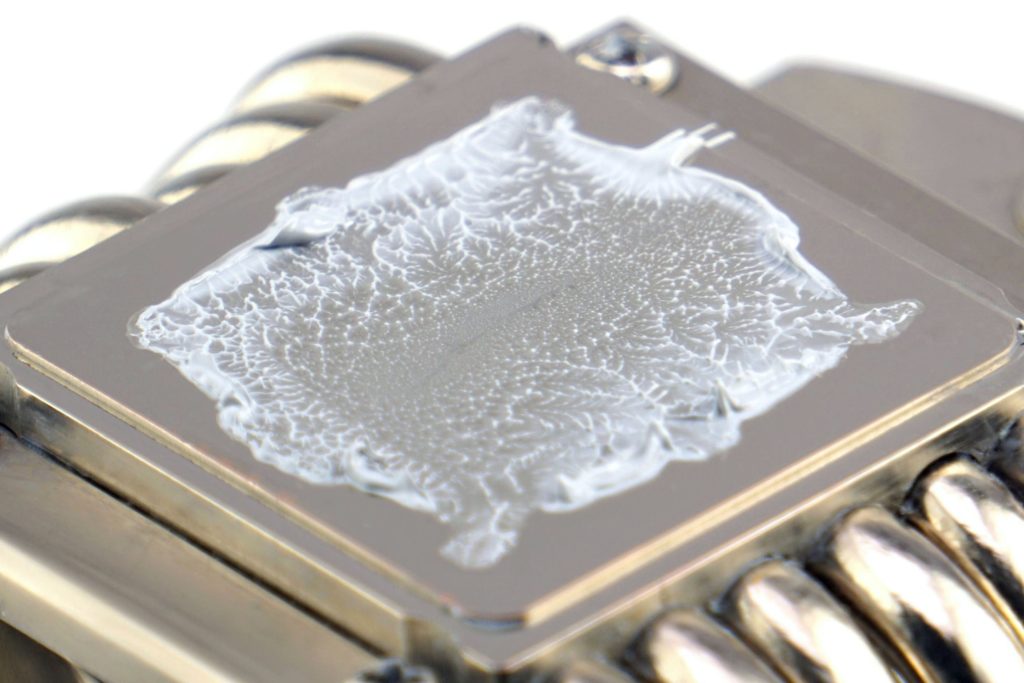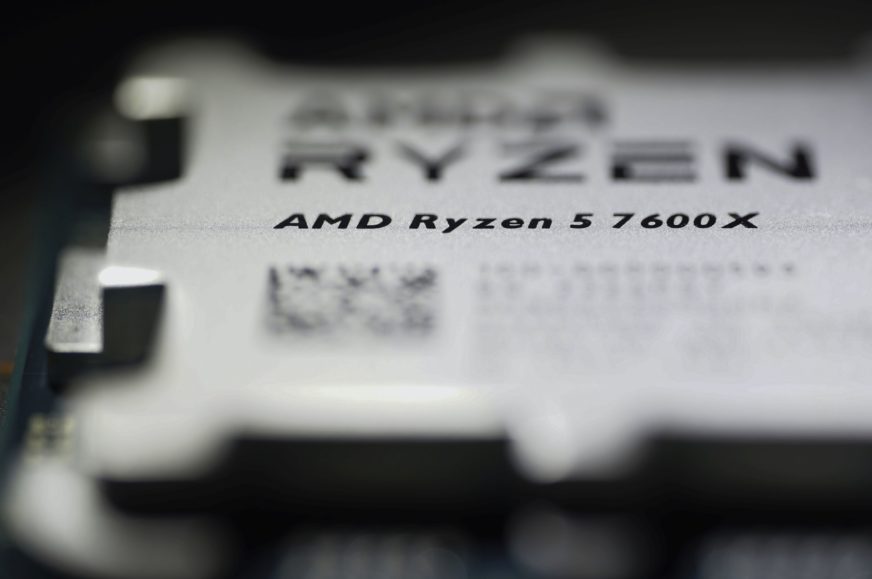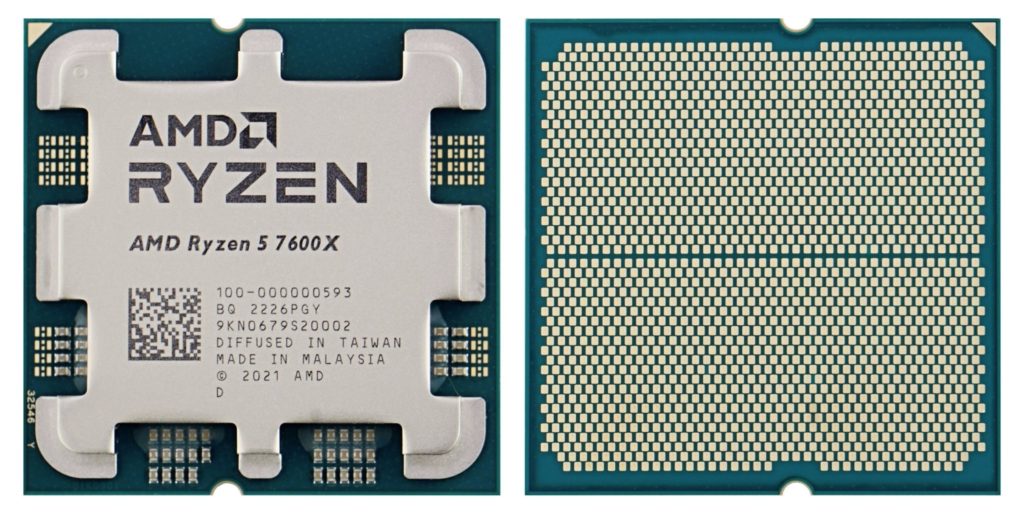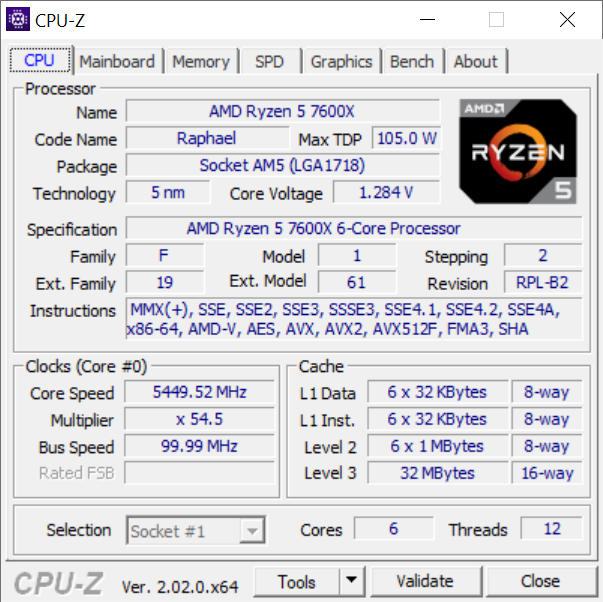AMD Ryzen 5 7600X in detail
The cheapest Ryzen 7000 processor (7600X) is a class above Intel’s cheapest Core i5-class processor (12400). Ryzen dominates in virtually everything, and it does so at higher efficiency. Yes, it’s not the same price range, and the R5 7600X is ultimately “killed” by the high price (not just in terms of the CPU itself, but the entire platform), but that doesn’t change the fact that it’s a great processor.
AMD Ryzen 5 7600X in detail
The six-core Ryzen 5 7600X will have similar birth pangs as its predecessor (Ryzen 5 5600X) had back in the day. What is this all about? About the somewhat disqualifying introductory price, which is too high compared to competing processors. The Ryzen 7600X has it even worse compared to the Ryzen 5 5600X because DDR4 memory is no longer enough, but more expensive DDR5 modules are required. Additionally, cheaper boards with B650 chipsets aren’t even available yet, which make more sense for the lower-end processors.
These are all well-known things that are most often talked about in hardware circles. Compared to Intel’s Core i5 (12400) with the best price/performance ratio (also for supporting cheaper DDR4 memory), this processor has no chance in mainstream builds. At least not yet, considering the price of the whole platform. Why are we writing this right up front and not leaving it for the conclusion? Because it’s not a world-shattering revelation, and we have plenty of more attractive findings ready for the always-powerful conclusion.
Sure, the cheapest Ryzen 7000 isn’t pitted against the cheapest Alder Lake Core i5, and most of the time it will face the Core i5-13600K (Raptor Lake), but within the current market situation, we’ll be pitting the R5 7600X against the Core i5-12400.
Taking price into account, the direct competitor from the current offer is, naturally, the Core i5-12600K. But there’s also the view that the lowest models in their respective classes sell the most, and here customers have been deciding for a long time between whether to save with Intel’s solution (typically the Core i5 “four hundred” series) or to pay more for AMD’s cheapest option. This is now again the “six hundred” Ryzen 5 with an X at the end of the designation like two years ago.
That is, compared to, say, the basic one (non-X) with lower clock speeds. But the latter is out of sight immediately after the release of the next generation, similar to what happened with the last ones (Ryzen 5000). So the Ryzen 5 7600 will probably not appear until later, if at all. For obvious reasons, sales of the faster model with higher margins take priority.
Extra cooling for 120 W as well
And there’s one more thing that we think it’s worth discussing in more detail now, when introducing the processor, rather than later (in the final summary of all the features). The Ryzen 5 7600X does have a significantly lower power draw, by 80 W compared to the Ryzen 9 7900X (TDP is 105 W and PPT is 142 W), but its temperatures are at a similar level. That’s because all the performance is concentrated on a smaller area, just a single chiplet (1× 71 mm2).
The performance of the Ryzen 9 7900X, while significantly higher, is spread across two chiplets (2× 71mm2). It’s actually similar to the Ryzen 7 5800X, which heated up significantly more at lower performance compared to the Ryzen 9 5900X. In this case, however, temperatures are lower than the Ryzen 9, even at higher clock speeds (for the R5 7600X) within the same CCX.
What’s noteworthy here in some ways is the comparison to the Ryzen 7 5800X3D. This is also a processor that only has performance resources within a single chipset, and also, to keep it cool, has more conservative clock speeds. Yet its operating characteristics (temperatures and power draw) are very similar to those of the Ryzen 5 7600X. The difference in power draw at maximum performance is 4 W (in favour of the R7 5800X3D) and in temperatures of just one degree Celsius. Of course, this only applies to our particular methodology, and with a different cooler or motherboard used, these ratios may be slightly different.

However, the results will always be very closely matched, showing that heat dissipation has not changed much between generations for the same output. What hasn’t changed either is the difference in chiplet area (although it’s 12 % smaller in the Ryzen 7000), and obviously the heat conduction properties of the TIM are very similar across generations, i.e. the chain from the qualitative aspects of the soldering of the processor, to the heat conduction efficiency of the material (which naturally includes thickness as well as composition), to the design of the heat spreader. Its area has been reduced in Ryzen 7000 processors, but this is relatively unimportant (as long as the thermal paste covers its entire area, which we will cover in a separate test).
The intensity of cooler pressure on the processor on the AMD AM5 socket will be the subject of various discussions. If it weren’t for the unreasonable saving of AIO cooler manufacturers on the backplate, this wouldn’t be an issue even with Intel LGA 1700. However, AMD’s more expensive boards don’t have their own backplate flat, but with protruding edges to significantly strengthen the PCB behind the CPU socket.
| Manufacturer | AMD | Intel | |
| Line | Ryzen 5 | Core i5 | |
| SKU | 7600X | 12400 | |
| Codename | Raphael | Alder Lake | |
| CPU microarchitecture | Zen 4 | Golden Cove (P) | |
| Manufacturing node | 5 nm + 6 nm | 7 nm | |
| Socket | AM5 | LGA 1700 | |
| Launch date | 09/26/2022 | 01/04/2022 | |
| Launch price | 299 USD | 192 USD | |
| Core count | 6 | 6 | |
| Thread count | 12 | 12 | |
| Base frequency | 4.7 GHz | 2.5 GHz (P) | |
| Max. Boost (1 core) | 5.3 GHz (5.45 GHz unofficially) | 4.4 GHz (P) | |
| Max. boost (all-core) | N/A | 4.0 GHz (P) | |
| Typ boostu | PB 2.0 | TB 2.0 | |
| L1i cache | 32 kB/core | 32 kB/core (P) | |
| L1d cache | 32 kB/core | 48 kB/core (P) | |
| L2 cache | 1 MB/core | 1,25 MB/core (P) | |
| L3 cache | 1× 32 MB | 1× 18 MB | |
| TDP | 105 W | 65 W | |
| Max. power draw during boost | 142 W (PPT) | 117 W (PL2) | |
| Overclocking support | Yes | No | |
| Memory (RAM) support | DDR5-5200 | DDR5-4800/DDR4-3200 | |
| Memory channel count | 2× 64 bit | 2× 64 bit | |
| RAM bandwidth | 83,2 GB/s | 76.8 GB/s or 51.2 GB/s (DDR4) | |
| ECC RAM support | Yes (depends on motherboard support) | No | |
| PCI Express support | 5.0 | 5.0/4.0 | |
| PCI Express lanes | ×16 + ×4 + ×4 | ×16 (5.0) + ×4 (4.0) | |
| Chipset downlink | PCIe 4.0 ×4 | DMI 4.0 ×8 | |
| Chipset downlink bandwidth | 8.0 GB/s duplex | 16.0 GB/s duplex | |
| BCLK | 100 MHz | 100 MHz | |
| Die size | 66,3 mm² + 118 mm² | ~209 or ~160 mm² (depending on variant) | |
| Transistor count | 6,57 + 3,37 bn. | ? bn. | |
| TIM used under IHS | Solder | Solder | |
| Boxed cooler in package | No | Intel Laminar RM1 | |
| Instruction set extensions | SSE4.2, AVX2, FMA, SHA, VAES (256-bit), AVX-512, VNNI | SSE4.2, AVX2, FMA, SHA, VNNI (256-bit), GNA 2.0, VAES (256-bit) | |
| Virtualization | AMD-V, IOMMU, NPT | VT-x, VT-d, EPT | |
| Integrated GPU | AMD Radeon | UHD 730 | |
| GPU architecture | RDNA 2 | Xe LP (Gen. 12) | |
| GPU: shader count | 128 | 24 | |
| GPU: TMU count | 8 | 12 | |
| GPU: ROP count | 4 | 8 | |
| GPU frequency | 400–2200 MHz | 350–1550 MHz | |
| Display outputs | DP 2.0, HDMI 2.1 | DP 1.4a, HDMI 2.0b | |
| Max. resolution | 3840 × 2160 px (60 Hz) | 5120 × 3200 px (60 Hz) | |
| HW video encode | HEVC, VP9 | HEVC, VP9 | |
| HW video decode | AV1, HEVC, VP9 | AV1, HEVC, VP9 |
- Contents
- AMD Ryzen 5 7600X in detail
- Methodology: performance tests
- Methodology: how we measure power draw
- Methodology: temperature and clock speed tests
- Test setup
- 3DMark
- Assassin’s Creed: Valhalla
- Borderlands 3
- Counter-Strike: GO
- Cyberpunk 2077
- DOOM Eternal
- F1 2020
- Metro Exodus
- Microsoft Flight Simulator
- Shadow of the Tomb Raider
- Total War Saga: Troy
- Overall gaming performance
- Gaming performance per euro
- PCMark and Geekbench
- Web performance
- 3D rendering: Cinebench, Blender, ...
- Video 1/2: Adobe Premiere Pro
- Video 2/2: DaVinci Resolve Studio
- Graphics effects: Adobe After Effects
- Video encoding
- Audio encoding
- Broadcasting (OBS and Xsplit)
- Photos 1/2: Adobe Photoshop and Lightroom
- Photos 2/2: Affinity Photo, Topaz Labs AI Apps, ZPS X, ...
- (De)compression
- (De)cryption
- Numerical computing
- Simulations
- Memory and cache tests
- Processor power draw curve
- Average processor power draw
- Performance per watt
- Achieved CPU clock speed
- CPU temperature
- Conclusion











Thanks, very thorough as usual.
Could you do a comprehensive review on Ryzen 7000 Eco Modes? I like the idea of lowering both power consumption (and temps) and clocks. Not everyone needs 5 ghz and above. In fact I think most don’t.
“Eco mode” will be dealt with in the framework of the motherboard tests. We won’t include it in standard CPU tests, those are at the limit of the maximum time we can invest in them. Eco mode will be here, it just won’t be included in the CPU test methodology, but you will find it in the motherboard test methodology. Just as we now measure, with Intel chipsets, with power limits based on TDP in motherboard tests, we will also reserve space for measurements in Eco mode for the AMD platform.
Thanks for the reply.